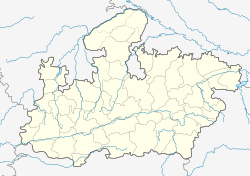Sailana
|
Sailana सैलाना |
|
|---|---|
| city | |
| Location in Madhya Pradesh, India | |
| Coordinates: 23°28′N 74°55′E / 23.47°N 74.92°ECoordinates: 23°28′N 74°55′E / 23.47°N 74.92°E | |
| Country |
|
| State | Madhya Pradesh |
| District | Ratlam |
| Founded by | Raja Jai Singh Rathore |
| Elevation | 479 m (1,572 ft) |
| Population (2001) | |
| • Total | 10,903 |
| Languages | |
| • Official | Hindi |
| Time zone | IST (UTC+5:30) |
Sailana is a town and a nagar panchayat in Ratlam district in the Indian state of Madhya Pradesh. It is located in the Malwa region of Madhya Pradesh. Sailana is 25 km from Ratlam town and 50 km away from Banswara district of the neighboring state of Rajasthan.
Sailana was once the capital of the Sailana State before it merged into India. A Fort belonging to the former royal family still stands tall in Sailana, and houses the famous Cactus Garden. The Kedareshwar temple, situated 4 km from Sailana is a notable shrine. Sailana is only 130 km away from Ujjain and as such makes a great weekend getaway. The best time to visit is July–August in the monsoons.
According to tradition, the town derived its name from its location at the foot of the hills (in Sanskrit, anana means mouth and shaila means hills).
Sailana State was founded by Jai Singh, great-grandson of Maharaja Ratan Singh, founder of Ratlam State. In 1716 Jai singh took revenge against his uncle for the murder of his father, he killed him in a pitched battle at sagode and secured Ratlam for his elder brother. The two brothers then divided the state between themselves. Jai singh's capital was initially at Raoti. He built Sailana city as his new capital in 1736. He fought 22 battles in his lifetime, turning Sailana into an independent state. During Raja Mokham Singh's rule, Sailana suffered in war against the Scindias of Gwalior, most of the states eastern and southern lands were annexed. Raja Lakshman Singh of Sailana tried to push the Scindia's out of his kingdom, in 1818 he refused to pay chauth which was regularly levied, the Scindias retaliated by sending an army under Bujang Rao, the Gwalior army which had European arms and was French trained lost its advantage on the hills en route to Sailana and was defeated by Lakshman Singh, the captured soldiers were allowed to leave but all of their guns and artillery were taken. On 5 January 1819, John Malcolm mediated between Gwalior and Sailana upon which Raja Lakshman Singh accepted British protection and agreed to pay a fixed tribute of 42,000 Salim Shahi to Gwalior, in return for Scindia agreeing to refrain from any interference in Sailana. During British rule Sailana saw development under the capable hands of Raja Jaswant Singh and then under his son Raja Dilip Singh, many reforms were introduced over the coming years, with particular attention being paid to education and the provision of vernacular educational facilities. By 1947, education and medical aid were provided free of charge, the local municipality was placed on a democratic footing and the judiciary and executive made independent of each other. Although the economy was primarily agricultural, some limited industrialisation included oil mills, and iron and steel works. On 15 June 1948, Raja Dilip Singh signed the accession to the Indian Union.
...
Wikipedia


